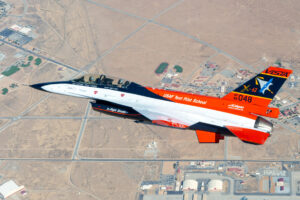TL;DR – The world of aviation has reached a new milestone with the recent dogfight between a human-piloted F-16 and an AI-controlled F-16, marking a significant leap in the integration of artificial intelligence into military operations (The Aviationist).
I usually write about AI use cases like creating images, videos, and songs. But while I was busy with that, the Department of Defense was implementing AI technology into unmanned aerial systems (drones) and legitimate fighter aircraft, such as the F-16.
Perhaps we should be following these developments more closely because serious technology is being put into serious weapons of war, and these developments will undoubtedly cause some concern, intrigue, and speculation among the public.
Let’s get into the details of this groundbreaking event and explore its implications for the future of air combat.
A New Age of Air Combat
DARPA, the Defense Advanced Research Projects Agency, has been at the forefront of pushing technological boundaries. The AI-controlled F-16 aircraft, known as the X-62A VISTA (Variable Stability In-flight Simulator Test Aircraft), engaged in real-world dynamic air combat scenarios against a human-piloted F-16 (The Debrief). This engagement is part of DARPA’s Air Combat Evolution (ACE) program, which aims to explore the potential of AI in high-stakes environments like aerial combat.

The Technology Behind the AI F-16
The AI controlling the X-62A is built on machine learning, allowing it to make real-time decisions during combat.
Unlike traditional rule-based autonomous systems that operate on predefined instructions, this AI can learn and adapt to dynamic scenarios, similar to how human pilots adjust their tactics based on experience (The Debrief).
Rule-based AI systems operate on predefined instructions and follow a set of programmed rules to make decisions. This approach is straightforward and deterministic, meaning its actions are predictable given the same set of inputs. These systems cannot learn from new data or adapt to situations that weren’t explicitly anticipated by their developers.
In contrast, the software used in the X-62A VISTA embodies machine learning algorithms, enabling it to analyze and learn from experiences dynamically. This allows the AI to devise innovative strategies and adjust its tactics in real time, offering a level of adaptability and decision-making akin to human cognition. Such an AI can go beyond the limits of its initial programming and improve its performance over time through learning, which is a critical advantage in the unpredictable scenarios of aerial combat. This adaptability is crucial for an AI system to be effective in complex combat situations.

Safety and Ethical Considerations
Safety is a top priority in any military operation, and DARPA has taken steps to ensure the AI operates within strict safety norms. The AI-controlled X-62A carries two human pilots during tests to monitor the aircraft and ensure safety. They can take control at any moment if the need arises, reinforcing trust in AI technology (The Debrief). This focus on safety is essential to gaining public acceptance and trust in AI-driven combat systems.
The ethical issues with AI-controlled fighter jets go beyond safety to broader debates about autonomy, accountability, and the future of warfare. Central to these discussions is how decisions are made in combat, especially regarding lethal force. AI, despite its advanced learning capabilities, lacks the complex understanding and moral reasoning of human pilots. This raises important questions about who is accountable when AI decisions result in civilian harm or unintentionally escalate conflicts.
Introducing AI into aerial combat also presents challenges to international law and engagement rules, where human judgment is crucial. The potential for an “AI arms race” among nations could destabilize global peace and increase conflict risks. It’s vital to balance tech advances with ethical considerations and international standards to ensure AI in military use promotes global security.
Moreover, the easy access to AI technology raises concerns about misuse by non-state actors or rogue groups, highlighting the need for strict international control and oversight. While AI in military tech has significant benefits, a cautious and ethical approach is necessary to minimize risks and maintain ethical warfare conduct.

The Significance of the AI vs. Human Dogfight
This dogfight represents a significant step forward in the evolution of air combat. It demonstrates that AI can handle complex decisions, potentially reducing risks for human pilots in dangerous combat scenarios. The rapid progress of DARPA’s ACE program suggests that AI could play a larger role in future military operations (The Aviationist).
Challenges and Future Outlook
Despite the successes, there are challenges to integrating AI into real-world combat situations. Technical hurdles, safety concerns, and ethical considerations must be addressed to ensure AI’s responsible use in combat. DARPA is committed to overcoming these challenges and continues to work on refining the technology (The Debrief). As the program progresses, there’s a potential for AI to become an integral part of future air combat.
Conclusion
The dogfight between an AI-controlled F-16 and a human-piloted F-16 is a landmark moment in military aviation. It showcases the potential for AI to revolutionize air combat tactics and strategy. While there are challenges ahead, this event indicates a future where AI plays a significant role in reducing risks for human pilots and enhancing combat capabilities. The story of the AI F-16 dogfight has only just begun, and its impact on the future of air combat will be fascinating to witness.
Cheers!
This is a Contributor Post. Opinions expressed here are opinions of the Contributor. Influencive does not endorse or review brands mentioned; does not and cannot investigate relationships with brands, products, and people mentioned and is up to the Contributor to disclose. Contributors, amongst other accounts and articles may be professional fee-based.

